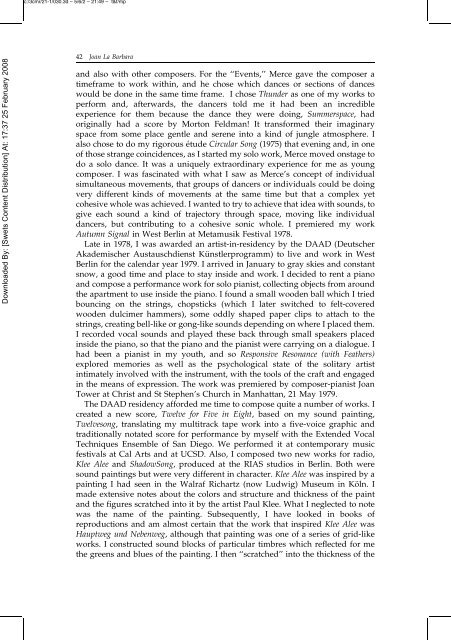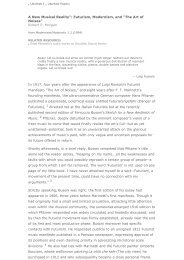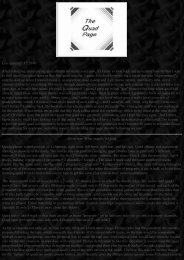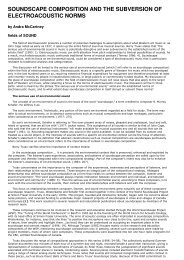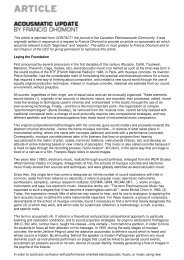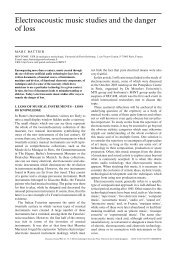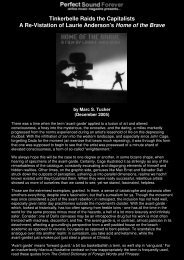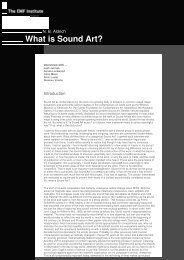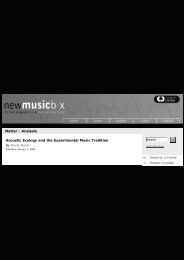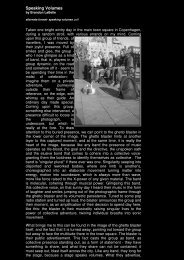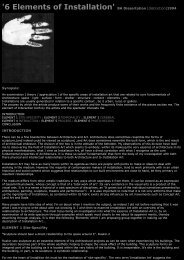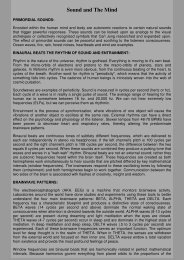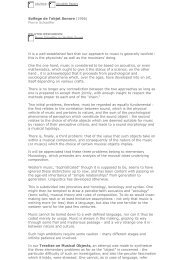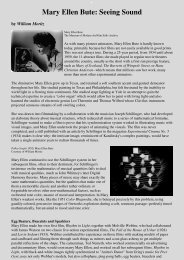La_Barbara-2002-Voice is the original instrument.pdf
La_Barbara-2002-Voice is the original instrument.pdf
La_Barbara-2002-Voice is the original instrument.pdf
You also want an ePaper? Increase the reach of your titles
YUMPU automatically turns print PDFs into web optimized ePapers that Google loves.
c:/3cmr/21-1/030.3d ±5/6/2 ± 21:49 ± t&f/mpDownloaded By: [Swets Content D<strong>is</strong>tribution] At: 17:37 25 February 200842 Joan <strong>La</strong> <strong>Barbara</strong>and also with o<strong>the</strong>r composers. For <strong>the</strong> ``Events,'' Merce gave <strong>the</strong> composer atimeframe to work within, and he chose which dances or sections of danceswould be done in <strong>the</strong> same time frame. I chose Thunder as one of my works toperform and, afterwards, <strong>the</strong> dancers told me it had been an incredibleexperience for <strong>the</strong>m because <strong>the</strong> dance <strong>the</strong>y were doing, Summerspace, had<strong>original</strong>ly had a score by Morton Feldman! It transformed <strong>the</strong>ir imaginaryspace from some place gentle and serene into a kind of jungle atmosphere. Ialso chose to do my rigorous eÂtude Circular Song (1975) that evening and, in oneof those strange coincidences, as I started my solo work, Merce moved onstage todo a solo dance. It was a uniquely extraordinary experience for me as youngcomposer. I was fascinated with what I saw as Merce's concept of individualsimultaneous movements, that groups of dancers or individuals could be doingvery different kinds of movements at <strong>the</strong> same time but that a complex yetcohesive whole was achieved. I wanted to try to achieve that idea with sounds, togive each sound a kind of trajectory through space, moving like individualdancers, but contributing to a cohesive sonic whole. I premiered my workAutumn Signal in West Berlin at Metamusik Festival 1978.<strong>La</strong>te in 1978, I was awarded an art<strong>is</strong>t-in-residency by <strong>the</strong> DAAD (DeutscherAkadem<strong>is</strong>cher Austauschdienst KuÈ nstlerprogramm) to live and work in WestBerlin for <strong>the</strong> calendar year 1979. I arrived in January to gray skies and constantsnow, a good time and place to stay inside and work. I decided to rent a pianoand compose a performance work for solo pian<strong>is</strong>t, collecting objects from around<strong>the</strong> apartment to use inside <strong>the</strong> piano. I found a small wooden ball which I triedbouncing on <strong>the</strong> strings, chopsticks (which I later switched to felt-coveredwooden dulcimer hammers), some oddly shaped paper clips to attach to <strong>the</strong>strings, creating bell-like or gong-like sounds depending on where I placed <strong>the</strong>m.I recorded vocal sounds and played <strong>the</strong>se back through small speakers placedinside <strong>the</strong> piano, so that <strong>the</strong> piano and <strong>the</strong> pian<strong>is</strong>t were carrying on a dialogue. Ihad been a pian<strong>is</strong>t in my youth, and so Responsive Resonance (with Fea<strong>the</strong>rs)explored memories as well as <strong>the</strong> psychological state of <strong>the</strong> solitary art<strong>is</strong>tintimately involved with <strong>the</strong> <strong>instrument</strong>, with <strong>the</strong> tools of <strong>the</strong> craft and engagedin <strong>the</strong> means of expression. The work was premiered by composer-pian<strong>is</strong>t JoanTower at Chr<strong>is</strong>t and St Stephen's Church in Manhattan, 21 May 1979.The DAAD residency afforded me time to compose quite a number of works. Icreated a new score, Twelve for Five in Eight, based on my sound painting,Twelvesong, translating my multitrack tape work into a ®ve-voice graphic andtraditionally notated score for performance by myself with <strong>the</strong> Extended VocalTechniques Ensemble of San Diego. We performed it at contemporary musicfestivals at Cal Arts and at UCSD. Also, I composed two new works for radio,Klee Alee and ShadowSong, produced at <strong>the</strong> RIAS studios in Berlin. Both weresound paintings but were very different in character. Klee Alee was inspired by apainting I had seen in <strong>the</strong> Walraf Richartz (now Ludwig) Museum in KoÈln. Imade extensive notes about <strong>the</strong> colors and structure and thickness of <strong>the</strong> paintand <strong>the</strong> ®gures scratched into it by <strong>the</strong> art<strong>is</strong>t Paul Klee. What I neglected to notewas <strong>the</strong> name of <strong>the</strong> painting. Subsequently, I have looked in books ofreproductions and am almost certain that <strong>the</strong> work that inspired Klee Alee wasHauptweg und Nebenweg, although that painting was one of a series of grid-likeworks. I constructed sound blocks of particular timbres which re¯ected for me<strong>the</strong> greens and blues of <strong>the</strong> painting. I <strong>the</strong>n ``scratched'' into <strong>the</strong> thickness of <strong>the</strong>


